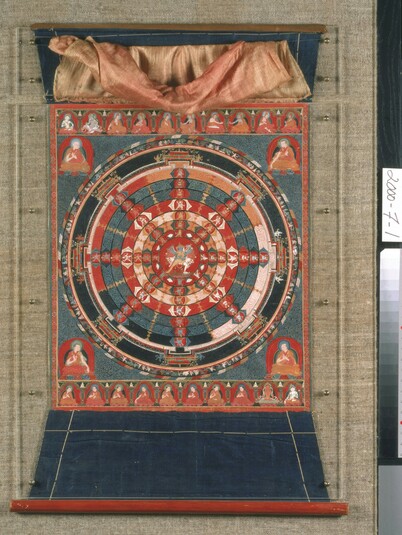
Item: Mandala of Kalachakra (Buddhist Deity) - Mahasamvara
| Origin Location | Central Tibet |
|---|---|
| Date Range | 1500 - 1599 |
| Lineages | Sakya and Ngor (Sakya) |
| Size | 50.80x44.45cm (20x17.50in) |
| Material | Ground Mineral Pigment on Cotton |
| Collection | Philadelphia Museum of Art |
| Catalogue # | acc. #2000-7-1, Stella Kramrisch Fund, 2000 |
Mahasamvara Kalachakra, Seventy-three Deity Mandala. The painting was commissioned by Lhachog Sengge (1468-1535), the 9th abbot of Ngor Ewam Monastery.
Video: Sixteen Cemeteries
Sanskrit: Kalachakra Tibetan: Du kyi kor lo
Tibetan: Du kyi kor lo
Kalachakra is surrounded by eight couples in embrace. Outside of that are six concentric weapon wheels, jnana, bhumi, vari, jvala, vayu and akasha. Each of these wheels has eight couples in embrace. The mandala palace is circular and has eight gates. Surrounding the palace is the ring of sixteen great charnel grounds unique to the Kalachakra Tantra.
The source text is the Paramadi-buddhoddhrta-srikalachakra-nama-tantraraja, Toh 362. Further information for this mandala can be found in the Ngor Mandala compilation of the 19th century rgyud sde kun btus, mandala #98, dus 'khor sdom chen lha bdun cu don gsum gyi dkyil 'khor. Also see The Ngor Mandalas of Tibet, Listings of the Mandala Deities. bSod nams rgya mthso. Bibliotheca Codicum Asiaticorum 4. The Centre for East Asian Cultural Studies, 1991. Again, Tibetan Mandalas (Vajravali and Tantra-samuccaya), Raghuvira and Lokesh Chandra, 1995.
Lineage Teachers: Buddha Kalachakra, Chandrabhadra and the Eight Kings, Manjushr-kirti and the Twenty-five Vidyadharas; Vidyadhara Shripala, Kalachakrapada the Greater, Kalachakrapada the Lesser, the Kashmiri Chandra Nata, Gompa Konchog Srung, Droton Namla Tseg, Yumo Mikyo Dorje, Se Dharmeshvari, Drubtob Namkha Ozer, Drubtob Semoche Namka Gyaltsen, Jamsar Sherab Ozer, Lama Choku Ozer, Choje Kunpangpa, Jangsem Gyalwa Yeshe, Lama Kunkyen Pagpa, Buton Rinchen Drub (1290-1364), etc. (rgyud se bkun btus, 2004 edition, vol. 30, pages 171-173).
Jeff Watt 7-2003 [updated 7-2009]
"...Shri Kalachakra shining forth with stainless light rays of five [colours], with a body blue in colour. Having three necks the central is blue, right red and left white. The main face is black and fierce with bared teeth. The right face is red and desirous. The back face is yellow and in samadhi. The left face is white and very peaceful. Each face has three eyes.
The hair is tied in a tuft [along with] a vishvavajra, crescent moon, and Vajrasattva as a crown, a vajra jewel, vajra earrings, vajra necklace, vajra bracelets, vajra belt, vajra anklets, vajra scarf, vajra mala, and a loose tiger skin skirt.
The first [two] shoulders on the right and left are blue, second red, third white, for a [total] of six [pairs] of shoulders, twelve upper arms and twenty-four hands. The first four [right and left] are black, second four red, third four white. The thumbs of all the hands are yellow, index finger white, middle finger red, ring finger black, and little finger green. The first knuckle is black, second red, third white. All of the fingers are beautiful and radiant.
The first four black right hands hold a vajra, sword, trident and curved knife. The four red [hold] a flaming arrow, vajra hook, a rattling damaru and hammer. The four white [hands hold] a wheel, spear, stick and a battle axe.
The first four black left [hands] hold a vajra bell, shield, katvanga and a skullcup filled with blood. The four red [hold] a bow, vajra lasso, jewel and a white lotus. The four white [hold] a conch, mirror, vajra chain and the four-faced head of Brahma adorned with lotus [flowers].
Above a moon, sun and rahu, standing in a very playful manner, the right red leg is extended atop red Kamadeva having one face and four hands, holding five flower arrows, a bow, lasso and a hook. Under the left white leg is Rudra, white with one face, three eyes and four arms, holding a trident, damaru drum, skullcup and a katvanga. The demon [consorts] Rati and Uma in a woeful [manner] hold the soles [of Kalachakra's feet].
Vishvamata, yellow in colour, embraces [Kalachakra] from the front. The faces, from the right are yellow, white, blue and red, each with three eyes. There are eight arms. The [first] right hands hold a curved knife, hook, a rattling damaru and bead mala. The left [hands hold] a skullcup, lasso, white lotus with eight petals and a jewel. Vajrasattva [appears] as a crown. Adorned with the five mudras. The left leg is extended - standing together with the Bhagavan." (Buton Tamche Kyenpa Rinchen Drub, 1290-1364. dus 'khor sgrub thabs bsdus pa rin po che'i snying po. gsung 'bum rin chen grub [zhol par khang] Volume 5, Pages 163-176. [TBRC W1934])
Jeff Watt [updated 6-2019]
Front of Painting
Wylie Transliteration of Inscription: yi dam dkyil 'khor gyi lha tshogs 'di bdag dge slong rdo rje 'dzin pa lha chog seng ge'i yi dam du bzhengs . mang ga la.
Exhibition: Mandala, The Perfect Circle (RMA)
Thematic Sets
Buddhist Deity: Kalachakra, Mahasamvara
Subject: Ngor Masterworks
Collection of Philadelphia Museum of Art (Sakya Masterpieces)
Collection of Philadelphia Museum of Art (Masterworks)
Buddhist Deity: Kalachakra (Mandala Masterworks)
Teacher: Lhachog Sengge (Commissioned Paintings)
Mandala: Sakya Masterworks
Collection of Philadelphia Museum of Art: Mandala (Masterworks)
Collection of Philadelphia Museum of Art: Sakya Tradition
Collection of Philadelphia Museum of Art: Sakya Mandalas
Mandala: Mandala Main Page
Tradition: Sakya Deity Paintings
Buddhist Deity: Kalachakra Main Page
Mandalas: Sakya Tradition
Buddhist Deity: Kalachakra Mandala (Masterworks)
Textile: Composition & Finishing
Textile: Mounts (Early Style)
Collection of Philadelphia Museum of Art: Mandala Paintings
Collection of Philadelphia Museum of Art
Buddhist Deity: Kalachakra Mandala
